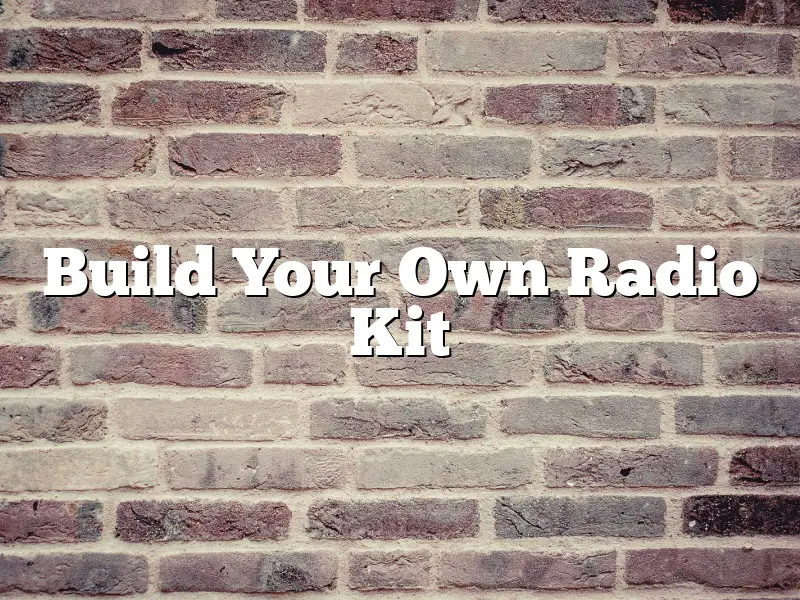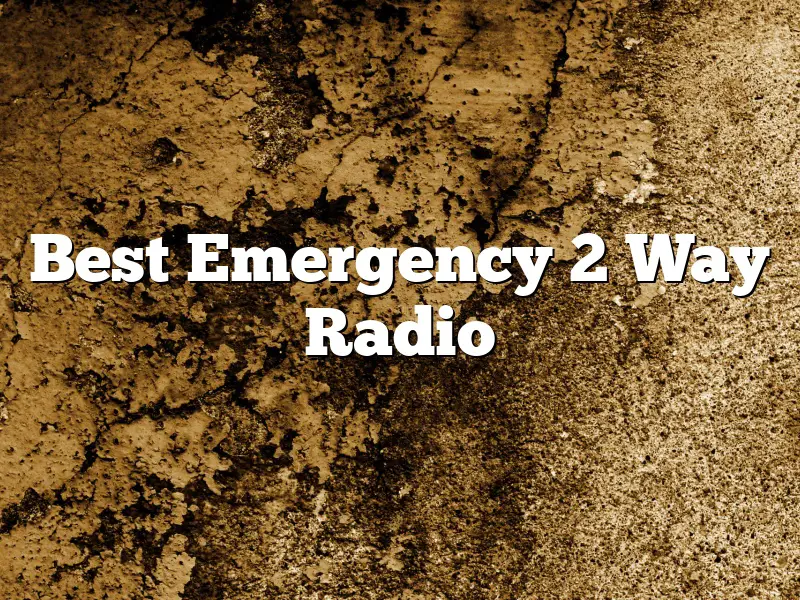Do you enjoy listening to the radio? Do you like the idea of being able to control what you hear? If so, you may want to consider building your own radio kit. This is a great way to get familiar with the inner workings of a radio and to customize your listening experience.
There are a few different ways to go about building your own radio kit. You can buy a kit that already has all the parts you need, or you can gather the parts yourself. If you choose to buy a kit, be sure to read the reviews before purchasing one. There are a few kits on the market that are not very high quality.
If you choose to gather the parts yourself, there are a few things you will need to know. The first thing you need to know is the frequency of the radio station you want to listen to. You can find this information online or in a radio guide. The next thing you need to know is the type of antenna you will need. This information can also be found online or in a radio guide.
Once you have the necessary information, it’s time to start gathering the parts. The most important part of the kit is the receiver. This is the part of the kit that will convert the radio signal into sound. You can find receivers at your local electronics store or online.
The next most important part of the kit is the antenna. The type of antenna you need will depend on the frequency of the radio station you want to listen to. There are a few different types of antennas, so be sure to do your research before purchasing one.
The last part of the kit is the speaker. The speaker is what you will use to listen to the radio. You can find speakers at your local electronics store or online.
Once you have all the parts, it’s time to put the kit together. This is a fairly simple process, and most kits come with instructions. Be sure to read the instructions thoroughly before beginning.
Once the kit is assembled, it’s time to test it out. Connect the antenna to the receiver and the receiver to the speaker. Turn on the radio and tune to the frequency of the station you want to listen to. If everything is working correctly, you should be able to hear the broadcast.
Building your own radio kit is a fun and rewarding experience. It’s a great way to learn about the inner workings of a radio and to customize your listening experience.
Contents
How can I make a homemade radio?
Making a homemade radio is a fun and easy project that can be completed with a few basic supplies. All you need is a cardboard tube, some wire, a resistor, a diode, and a 9-volt battery.
To begin, cut the cardboard tube into two equal halves. Next, use a sharp knife to poke a small hole in the center of one end of the tube. This will be the mouthpiece of the radio.
Next, use a piece of wire to create a coil. Wind the wire around the tube, starting at the mouthpiece and spiraling towards the opposite end. Leave about six inches of wire at the end.
Tie a resistor and a diode to the end of the wire. The resistor should have a value of between 470 and 1000 ohms, while the diode should be a type of silicon diode, such as a 1N914.
Finally, connect the 9-volt battery to the other end of the wire. Your radio is now ready to use.
To listen to the radio, hold the mouthpiece of the tube up to your ear and rotate the coil until you hear a clear signal. The farther you rotate the coil, the stronger the signal will be.
How can I make an FM radio at home?
Making your own FM radio can be a fun and rewarding project, and it’s not as difficult as you might think. In this article, we’ll show you how to make an FM radio using a few basic components.
The first thing you’ll need is an FM receiver module. This can be purchased from a variety of sources, including online retailers and hobby shops. The receiver module will contain all the circuitry necessary to decode FM signals and play them back through a speaker or headphones.
Next, you’ll need an audio amplifier module. This will amplify the audio signal from the receiver module so that it’s strong enough to drive a speaker. Again, you can purchase these modules from a variety of sources, or you can build your own if you’re feeling adventurous.
Finally, you’ll need a speaker or headphones to listen to the FM radio.
Once you have all the components, it’s just a matter of assembling them into a working unit. The wiring schematic is very simple, and the whole project can be completed in a few hours.
Here’s a brief overview of the steps involved:
1. Connect the FM receiver module to the audio amplifier module.
2. Connect the audio amplifier module to the speaker or headphones.
3. Power up the audio amplifier module.
4. Tune the FM receiver module to a desired station.
That’s all there is to it! With a little bit of effort, you can have your very own FM radio that you built yourself.
How do you make a homemade radio receiver?
Radio receivers come in all shapes and sizes, from the small and simple AM/FM radios found in most homes, to the more complex and expensive shortwave receivers. While there are many commercially made radios available, it is also possible to build your own homemade radio receiver.
The first step in building a homemade radio receiver is to decide on the type of radio you want to build. There are many different types of radios, each with its own advantages and disadvantages. The most common type of radio is the AM/FM radio. AM (amplitude modulation) radios are the simplest type of radio to build and can be used to listen to local AM radio stations. FM (frequency modulation) radios are more complex to build, but can receive FM stations that are farther away than AM stations.
Another common type of radio is the shortwave receiver. Shortwave radios can receive radio stations from around the world that are transmitted on shortwave frequencies. Shortwave radios are more complex to build than AM/FM radios, but can be built using a few simple components.
Once you have decided on the type of radio you want to build, the next step is to gather the necessary components. Most homemade radios can be built using a few simple components, including an antenna, a coil of wire, a capacitor, and a few resistors.
The antenna is the most important component of a radio receiver. The antenna picks up the radio signals and sends them to the receiver. The type of antenna you use will depend on the type of radio you are building. AM/FM radios can use a simple wire antenna, while shortwave radios typically require a more complex antenna, such as a long wire antenna or a Yagi antenna.
The coil of wire is used to create the magnetic field that is necessary to detect the radio signals. The capacitor is used to store energy and release it at the correct time to create the oscillating current that is used to detect the radio signals. The resistors are used to limit the current and voltage in the circuit.
Once you have gathered all of the necessary components, the next step is to assemble the radio. This can be done using a simple breadboard or a soldering iron. Once the radio is assembled, the next step is to test it. This can be done by connecting the antenna to the receiver and tuning to a local AM or FM station. If you are building a shortwave receiver, you can test it by tuning to a shortwave frequency.
If the radio is not working correctly, the first step is to check the connections between the components. If the connections are correct, the next step is to troubleshoot the circuit. This can be done by checking the values of the resistors and the capacitors. If the values are not correct, the components may need to be replaced.
Once the radio is working correctly, the next step is to find a suitable location for it. AM/FM radios can be placed anywhere in the house, while shortwave radios need to be located near a window where they can pick up the signals from the radio station.
Building your own homemade radio receiver is a fun and rewarding project. It can be done using a few simple components and a little bit of knowledge about electronics. Once you have built your first radio, you will be hooked and will want to build more complex radios. So, get started and build your own homemade radio receiver today!
Can I build my own ham radio?
Ham Radio is a great way to communicate with other people all over the world. You can use it to talk to people in your own town, or you can use it to talk to people in other countries. You can also use it to talk to people on the other side of the planet.
Ham Radio is a great way to communicate with other people all over the world. You can use it to talk to people in your own town, or you can use it to talk to people in other countries. You can also use it to talk to people on the other side of the planet.
Ham Radio is a great way to communicate with other people all over the world. You can use it to talk to people in your own town, or you can use it to talk to people in other countries. You can also use it to talk to people on the other side of the planet.
Ham Radio is a great way to communicate with other people all over the world. You can use it to talk to people in your own town, or you can use it to talk to people in other countries. You can also use it to talk to people on the other side of the planet.
Ham Radio is a great way to communicate with other people all over the world. You can use it to talk to people in your own town, or you can use it to talk to people in other countries. You can also use it to talk to people on the other side of the planet.
Ham Radio is a great way to communicate with other people all over the world. You can use it to talk to people in your own town, or you can use it to talk to people in other countries. You can also use it to talk to people on the other side of the planet.
Ham Radio is a great way to communicate with other people all over the world. You can use it to talk to people in your own town, or you can use it to talk to people in other countries. You can also use it to talk to people on the other side of the planet.
Ham Radio is a great way to communicate with other people all over the world. You can use it to talk to people in your own town, or you can use it to talk to people in other countries. You can also use it to talk to people on the other side of the planet.
Ham Radio is a great way to communicate with other people all over the world. You can use it to talk to people in your own town, or you can use it to talk to people in other countries. You can also use it to talk to people on the other side of the planet.
Ham Radio is a great way to communicate with other people all over the world. You can use it to talk to people in your own town, or you can use it to talk to people in other countries. You can also use it to talk to people on the other side of the planet.
Ham Radio is a great way to communicate with other people all over the world. You can use it to talk to people in your own town, or you can use it to talk to people in other countries. You can also use it to talk to people on the other side of the planet.
Ham Radio is a great way to communicate with other people all over the world. You can use it to talk to people in your own town, or you can use it to talk to people in other countries. You can also use it to talk to people on the other side of the planet.
Ham Radio is a great way to communicate with other people all over the world. You
What is a crystal radio kit?
What is a crystal radio kit?
A crystal radio kit is a DIY project that allows you to build your own crystal radio. A crystal radio is a simple radio that doesn’t require an external power source, and instead gets power from the radio waves that are broadcasted through the air.
A crystal radio kit typically includes all the materials you need to build your own crystal radio, including a crystal, a coil of wire, a capacitor, and some resistors. It also includes instructions on how to put the kit together, as well as how to use the radio.
Crystal radios were first popularized in the early 1900s, and they remain a popular DIY project today. They are a great way to learn about radio technology, and they also make a great gift for someone who is interested in radios or electronics.
What are the materials to make a radio?
A radio is a device that receives and transmits radio waves to create sound. The most common type of radio is a broadcast radio, which can be received by anyone with a receiver within range. There are many different ways to make a radio, but the most common materials are metal, plastic, and glass.
Metal is a common material for making a radio because it is a good conductor of electricity. It is used to create the antenna and the chassis, which are the two main parts of a radio. The antenna is the part of the radio that picks up the radio waves, and the chassis is the part of the radio that houses the electronic components.
Plastic is a common material for making a radio case because it is strong and durable. It is used to create the radio’s outer casing, which protects the electronic components from damage.
Glass is a common material for making a radio’s display. It is used to create the display window, which allows the user to see the radio’s settings and the frequency it is tuned to.
Are FM transmitters illegal?
FM transmitters are legal in most countries, but there are a few that have restrictions on their use. In the United States, for example, it is illegal to use an FM transmitter to send signals that interfere with licensed radio stations.
FM transmitters can be used to improve the sound quality of music or other audio content played on a portable device, such as a smartphone or laptop. They can also be used to boost the signal of a radio station that’s being listened to in a car or other location where the signal might be weak.
FM transmitters are available in a variety of shapes and sizes, and they can be powered by a battery or plugged into an electrical outlet. Some models include an amplifier to boost the signal, and others have a built-in antenna.
FM transmitters can be used to create a small, private radio station that can be listened to by a small group of people. They can also be used to send signals to a large audience, but this can be illegal in some countries if the signals interfere with licensed radio stations.
FM transmitters are a convenient way to improve the sound quality of audio content, and they can also be used to boost the signal of a radio station or create a private radio station. However, it is important to be aware of the restrictions that may apply in your country.



